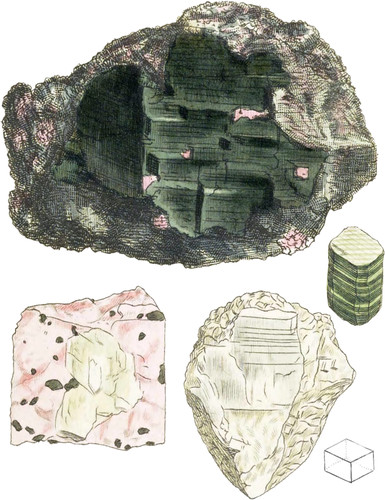 Enlarge
Enlarge
British Mineralogy
Hornblende
- Class 2. Earths.
- Ord. 1. Homogeneous.
- Gen. 4. Silex.
- Spec. 29. Hornblende.
- Div. 1. Crystallized.
- Syn.
- Amphibole. Haüy, Tabl. 39. Traité, 3. 58.
- Hornblende. Emmerl. 1. 323.
In tab. 79 of this work I have shown the Tirie Marble. I have since obtained better specimens of the substances contained in it. I therefore take it up again, to show what has been discovered relating to the green crystals in particular. By using smaller crystals than had before been tried, we found them to be fusible by the blowpipe. I should therefore consider them as decidedly Hornblende, did not there remain some doubts arising from other characters. Among the specimens I have obtained since my former figure are some crystals, the prismatic faces of which are tolerably well defined, and are eight in number; but their terminations are in general so much rounded and distorted that they cannot be reduced to an y regular form. Of the faces of the prism, four are much larger than the others. I obtained for the angle of the incidence of two of these faces which were tolerably flat, 88°; the incidence of one of the narrow faces upon one of these was about 135°: these angles agree very nearly with those of Haüy’s variety of Pyroxene, the perioctaëdre. The general appearance of these crystals is much like that of Sahlite, a mineral considered by Haüy as only a variety of Pyroxène: they have therefore often been called Sahlite by skilful Mineralogists, and the measures I have just given seem to confirm the opinion; but the internal structure, which is more to be depended upon, agrees better with that of Hornblende, The nucleus of Hornblende, according to Haüy, is an oblique rhomboidal prism, the sides of which measure 124° 34′ and 55° 26′ upon each other, with the terminal face inclined towards the obtuse edge, making with it an angle of 104° 57′.
The upper figure shows a massive specimen, analogous to the crystals whose faces are the result of breaking; the larger ones of these measure upon each other about 124°1/2, and the smaller ones, which are also indicated by striæ upon the larger, are found to be inclined upon the obtuse edge at an angle of apparently about 105°: but this angle is difficult to obtain correctly on account of the irregularity of the edges of the fragments. I have broken several prismatic crystals, and found them to agree precisely in their interior with this massive specimen. The lateral planes of the fragments obtained, gave within a few minutes of 124°1/2 for the obtuse angle of their incidence. From the evidence of these measures I conclude this substance to be a variety of Hornblende, and not Sahlite or a variety of Augite. There is, however, one circumstance worthy of notice; it is the extreme facility with which the terminal face of the prism is obtained by fracture in these crystals, whereas in common Hornblende it can scarcely ever be detected, nor is it indicated even by striæ. These crystals on the contrary are often almost foliated in the direction of it, and their surfaces marked by white lines, the edges of the plates in a decomposing state, which traverse them in that direction, as seen in tab. 79.
There are, besides the dark green I have just described many dull rounded grains of a much paler colour; but I presume that these differ only in colour, in which they both vary: it often happens that the light and dark grains are irregularly mixed among one another, but still remaining perfectly distinct: this would intimate a greater difference than colour between them, did we not meet with parallel instances in other substances, as the grey and red Feldspar mixed in the Sienite of Egypt. I regret that I have not been able to obtain fragments sufficiently perfect to determine this point. The lowest left hand figure shows an extraordinary large and pale coloured piece, but it is too compact and irregular to obtain a measure from. The right hand figure exhibits a specimen brought as Zoizite from Glen-elg in Inverness-shire, from which, however, it seems to be perfectly distinct: in form and fracture it does not differ from the upper specimen; in colour and lustre it agrees with the substance formerly mentioned as Corundum from Tirie, and serves to prove the identity of the light and dark green grains just mentioned. It is a variety of Actinolite distinguished by most authors as Tremolite, which Haüy from recent measurements has been induced to class as a variety of Amphibole or Hornblende. See Haüy’s Tableau, p. 173.
The little red stones mentioned under tab. 79 are now found to be Siliceo-calcareous Titanium or Sphéne, of a brownish red colour, by the penetrating Dr. Wollaston, who nevertheless finds the marble to be coloured by Iron alone. Besides these, there are many grains of white Quartz, reddish Feldspar, laminated white Carbonate of Lime, and in some parts small plates of brown Mica.
The Hornblende grains sometimes occur, collected in great numbers together, of both colours, the interstices between them filled with white laminated Carbonate of Lime, forming balls from one to twelve inches in diameter; these balls often contain Mica, and it is in their neighbourhood that the detached plates of Mica are found. The Quartz is also sometimes in large masses more or less penetrated by reddish Feldspar and a little Mica, forming balls of Granite of various sizes, among which the Hornblende is abundant.

